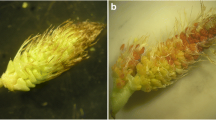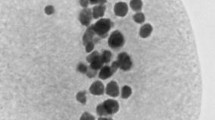Summary
Hybridization was carried out between two cultivars of Pelargonium crispum, ‘Prince Rupert’ and ‘Lemon crispum’. The parental cultivars both had 2n=22 chromosomes, and their hybrids had the same chromosome number. In most of the hybrids eleven bivalents were usually formed at metaphase 1, but in one plant asynapsis occurred in one to three pairs of homologous chromosomes. ‘Prince Rupert’ is male-sterile, but ‘Lemon crispum’ is male-fertile. The hybrids were more or less partially male-sterile in that their flowers had fertile and sterile anthers in varying degrees. The number of fertile anthers per flower differed between individual hybrids and also varied from flower to flower and from season to season even in the same hybrid. The fertile anthers contained both viable and abortive pollen grains, but the sterile ones abortive grains only. When anatomically examined, young microspores developed normally in all anthers. In the sterile anthers the microspores suddenly stopped their growth, and their cytoplasm became unrecognizable. In the fertile anthers, however, the microspores continued to grow and became mature pollen grains filled with cytoplasm. Such a type of male sterility as observed here is common in various Pelargonium species. It seems probable that the cause of the male sterility is not chromosomal but genic, and its expression is greatly influenced by environmental conditions.
Similar content being viewed by others
References
Berezina, N. M., 1962. Methods of production and economic significance of polyploid geranium (Pelargonium radula roseum W.). Trans. Moscow Soc. Naturalists 5: 274–279.
Chow, T. W. & P. M. Harney, 1970. Crossability between a diploid Pelargonium x hortorum Bailey cultivar and some of its putative ancestral species. Euphytica 19: 338–348.
Conagin, C. H. T. M., 1964. Cytological observations on Pelargonium. Bragantia 23: 23–37.
Daker, M. G., 1967. Cytological studies on a haploid cultivar of Pelargonium, and its colchicine-induced diploids. Chromosoma 21: 250–271.
Gauger, W., 1937. Ergebnisse einer zytologischen Untersuchung der Familie der Geraniaceae. I. Planta 26: 529–531.
Harney, P. M. & T. W. Chow, 1971. Crossability between some Pelargonium species. Euphytica 20: 286–291.
Harney, P. M. & H. C. C. Kung, 1967. Development of non-dehiscent anthers in partially male sterile plants of Pelargonium x hortorum Bailey cv. ‘Jacqueline’. Can. J. Genet. Cytol. 9: 359–366.
Nugent, P. E. & R. J. Snyder, 1967. The inheritance of floret doubleness, floret center color, and plant rabit in Pelargonium hortorum Bailey. Proc. Amer. Soc. hort. Sci. 91: 680–690.
Sansome, F. W., 1936. Some experiments with Geranium species. J. Genet. 33: 359–363.
Shchavinskaya, S. A., 1937. Restoration of fertility in the geranium (Pelargonium radula roseum W.) by doubling the chromosome complex. Bull. App. Bot. Genet. & Pl. Breed. II. 7: 101–106.
Takagi, F., 1928. On the chromosome numbers of Pelargonium. Sci. Rep. Tohoku Univ. Ser. 4. 3: 665–671.
Tamai, T. & S. Tokumasu, 1969. Studies on the breeding of Pelargonium species used for the essential oil production. V. Variation of some characters among interspecific hybrid plants between P. roseum and P. denticulatum. Jap. J. Breed. 19: 343–349.
Tamai, T., S. Tokumasu & S. Jodo, 1970. Studies on the breeding of Pelargonium species used for the essential oil production. VI. The characteristics of plants in backcross generations (B1 and B2) and the selection of an economically promising clone (B1 No. 10). Jap. J. Breed. 20: 88–95.
Tamai, T., S. Tokumasu & K. Shinohara, 1958. Studies on the breeding of Pelargonium species used for the essential oil production. I. Artificially induced tetraploid plant in Pelargonium roseum. Jap. J. Breed. 7: 131–138.
Tamai, T., S. Tokumasu & K. Yamada, 1963. Studies on the breeding of Pelargonium species used for the essential oil production. II. Artificially induced tetraploid plant in Pelargonium denticulatum. Jap. J. Breed. 13: 143–148.
Tokumasu, S., M. Kato & S. Jodo, 1972. On the triploid and the tetraploid obtained from natural crossing in Pelargonium roseum and P. denticulatum. Proc. Shikoku Meeting, Jap. Soc. Breed. 6: 28–29.
Tokumasu, S. & T. Tamai, 1964. Studies on the breeding of Pelargonium species used for the essential oil production. III. Cytological observation of Pelargonium denticulatum and P. roseum. Jap. J. Breed. 14: 107–111.
Author information
Authors and Affiliations
Rights and permissions
About this article
Cite this article
Tokumasu, S. Expression of male sterility in Pelargonium crispum L'Her. ex Ait. . Euphytica 23, 209–217 (1974). https://doi.org/10.1007/BF00035860
Received:
Issue Date:
DOI: https://doi.org/10.1007/BF00035860




